Summary
Revista Brasileira de Ginecologia e Obstetrícia. 2009;31(4):177-181
DOI 10.1590/S0100-72032009000400004
PURPOSE: to characterize, phenotypically, yeasts isolated from the vaginal content of 223 symptomatic (S) and asymptomatic (A) adult women with vulvovaginitis, and to determine the clinical indicators which may lead to the appearance of signs and symptoms related to the mucosa involvement by this pathology. METHODS: a questionnaire with open and closed questions on epidemiological clinical data was applied initially. Then, mycological diagnosis with sowing in Chrom Agar Candida was done, followed by micro-morphological and biochemical identification. Specific methods for the detection of the virulence factors, proteinase and phospholipase were employed. Statistical analysis was performed through χ2 and Pearson's χ2 tests. RESULTS: the most prevalent species found was Candida albicans (87%, S and 67%, A) followed by Candida glabrata (4%, S e 17% A). The number of women reporting the use of contraceptives was higher among the symptomatic, 77%. In the two groups studied, about 87% of the women presented regular menstrual cycles and 57% were married with ages between 30 to 40 years old. Concerning the sexual practices, there has been concomitance among anal, oral and vaginal habits from the patients. Only Candida albicans produced the virulence factor phospholipase in 37.5% of them. Proteinase has been detected in Candida albicans, Candida glabrata and Candida parapsilosis. This latter virulence factor was mainly associated to isolates from symptomatic patients. CONCLUSIONS: it is a fact that the vaginal mucosa can be colonized and infected by yeasts, with several Candida species present. Nevertheless, Candida albicans is the most prevalent in the vaginal mucosa of adult women. It is evident the emergence of non-albicans Candida species, some of them with intrinsic resistance to azolics, such as Candida glabrata, Candida parapsilosis, Candida tropicalis, and Candida guillermondii, which can be explained by the inadequate use of medicines and empirical treatment.
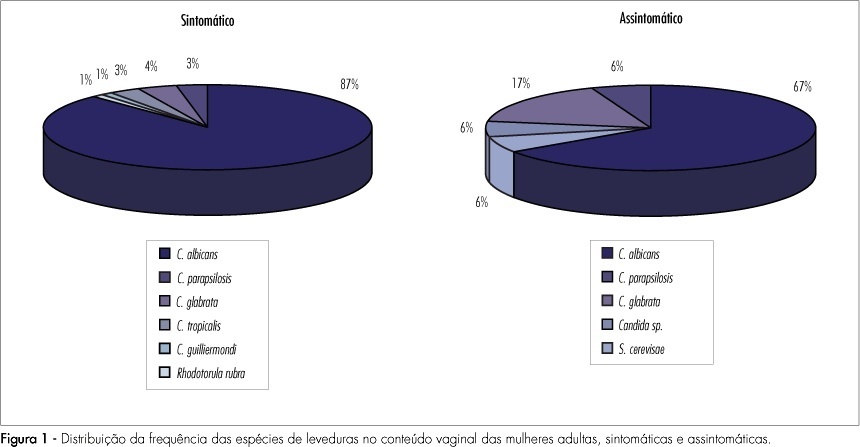
Summary
Revista Brasileira de Ginecologia e Obstetrícia. 2009;31(3):138-141
DOI 10.1590/S0100-72032009000300006
PURPOSE: to report three cases of spontaneous gestation in women with polycystic ovarian syndrome (PCOS), that occurred in the months subsequent to transvaginal oocyte retrieval for in vitro maturation (IVM). METHODS: three infertile patients with PCOS, submitted to oocytes' IVM without previous ovarian stimulation, were included in the study. During the procedure of oocytes' collection, each ovary was drilled from four to eight times. RESULTS: none of the patients got pregnant with the IVM technique. Evaluating the cases' follow-up, in seven months after the procedure, the three patients got pregnant without the help of techniques of assisted reproduction, which resulted in three births. CONCLUSIONS: the multiple drillings in the ovary of these patients with PCOS, during the process to collect oocytes, may have contributed to their pregnancy in the months following the procedure.
Summary
Revista Brasileira de Ginecologia e Obstetrícia. 2009;31(3):124-130
DOI 10.1590/S0100-72032009000300004
PURPOSE: to evaluate the effect of long-term use of a high dose of tibolone on the morphology of the endometrium of castrated female rats. METHODS: fifteen female Wistar rats, aged eight weeks and weighting about 250 g were used. All the female rats were submitted to bilateral oophorectomy and 30 days afterwards, vaginal cytology was collected, to verify the menopause status. The female rats were randomly divided in two groups. The Treatment Group (n=9) received 1 mg of tibolone/day orally; the Control Group (n=6) received a solution of carboxymethylcellulose vehicle. After 20 weeks of treatment, all the animals were sedated and sacrificed by cervical dislocation. The uterus was removed and fixated in 10% buffer formaldehyde. Both uterine horns were divided in three regions (proximal, medial and distal) and processed to be included in paraffin. Histological sections, stained with hematoxylin-eosin were submitted to morphological and morphometrical analysis. The following parameters have been analyzed: thickness of the endometrial superficial epithelium, thickness of the endometrium stroma, endometrial area, absolute number of endometrial glands and number of glands/endometrial area. The data obtained were compared by the t-Student test. RESULTS: in the Tibolone Group, the uteri were well developed and there was a significant increase (p<0.01) of all the histomorphometric parameters. In some cases, the cylindrical epithelium became stratified, pavimentous and covered the internal portions of the glands, as well as of the endometrium cavity. Rats from the Control Group presented uterine atrophy. There were few tubular-like glands and scarce intercellular substance. Glands were covered by cubic epithelium which extended itself to the endometrial cavity. CONCLUSIONS: high doses of tibolone, given for long periods of time to castrated female rats, have an estrogenic effect which can be dose-dependent, causing proliferation in the endometrium and causing changes in the cell differentiation (squamous metaplasia), but do not lead to hyperplasia.
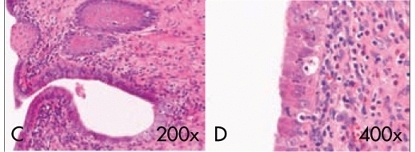
Summary
Revista Brasileira de Ginecologia e Obstetrícia. 2009;31(3):142-147
DOI 10.1590/S0100-72032009000300007
PURPOSE: to test the hypothesis that the anti-müllerian hormone (AMH) serum level reflects the antral follicles' response to the administration of FSH. METHODS: prospective study, including 116 normo-ovulatory infertile patients submitted to controlled ovarian hyperstimulation with GnRH and FSH agonists. The AMH serum level was measured after reaching the pituitary suppression and before the FSH administration (basal day). The number of antral follicles was determined by ultrasonography at the basal day (precocious antral follicles; 2 to 8 mm) and at the day of hCG administration (dhCG; pre-ovulatory follicles; >16 mm). The follicle response to FSH was determined by the percentage of precocious antral follicles which reached pre-ovulatory stage in response to FSH (maturation rate). The correlation of AMH with the patients' age, the total number of precocious antral and pre-ovulatory follicles, collected oocytes, total dose of FHS in the controlled ovarian stimulation and the rate of follicular maturation was studied. For the statistical analysis, it simple regression analysis and the Spearman's test were used, at a 5% significance level. RESULTS: The serum level of AMH was positively correlated with the number of precocious antral follicles at the basal day (r=0.64; p<0.0001) and pre-ovulatory follicles in dhCG (r=0.23; p=0.01). Exceptionally, the serum level of AMH was negatively correlated with the maturation ratio (r=-0.24; p<0.008). CONCLUSIONS: AMH attenuates the follicular development caused by FSH administration.
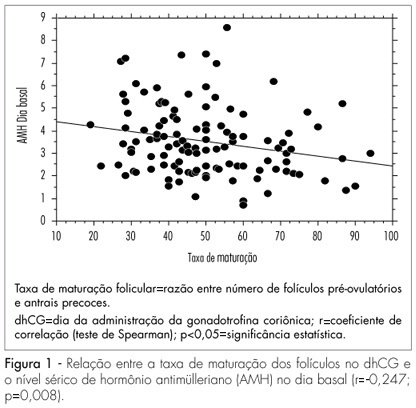
Summary
Revista Brasileira de Ginecologia e Obstetrícia. 2009;31(3):131-137
DOI 10.1590/S0100-72032009000300005
PURPOSE: to evaluate the effects of tamoxifen on the expression of TGF-β and p27 proteins in polyps and adjacent endometrium of women after menopause. METHODS: prospective study with 30 post-menopausal women with diagnosis of breast cancer, taking tamoxifen (20 mg/day), presenting diagnosis of suspect endometrial polyps through transvaginal ultrasonography, and submitted to diagnostic and surgical hysterectomy to withdraw the polyps and adjacent endometrium. A immunohistochemical study has been done to verify the expression of the TGF-β and p27 proteins in the polyps and adjacent endometrium. These proteins' quantification has been done by morphometry. RESULTS: the patients' average age was 61.7 years old; their average age at the menopause onset was 49.5; and the average of using tamoxifen was 25.3 months. The average concentration of positive cells for TGF-β protein in the glandular and stroma polyp epithelium was 62.6±4.5 cells/mm². For the p27, in the glandular polyp epithelium, it was 24.2±18.6 cells/mm² and for the stroma, 19.2±15.2 cells/mm². There was no significant difference between the expression of TGF-β and p27 in the glandular epithelial form the polyps and the adjacent endometrium. The expression of proteins in the polyp and adjacent endometrium with its respective glandular and stroma epithelium showed a significant difference for the p27 protein (r=0.9, p<0.05). CONCLUSIONS: we have concluded that the TGF-β expression is not related to the effect of tamoxifen on the growing of endometrial polyps, but the absence of polyps' malignization by tamoxifen may be explained by the high expression of p27 protein in its glandular epithelium.
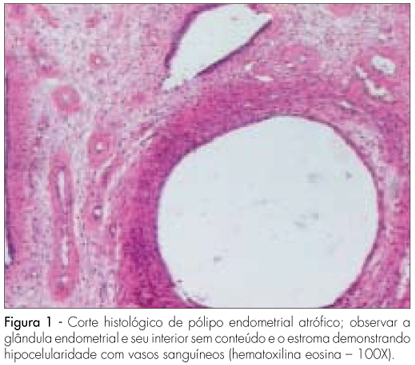
Summary
Revista Brasileira de Ginecologia e Obstetrícia. 2009;31(3):111-116
DOI 10.1590/S0100-72032009000300002
PURPOSE: to evaluate whether the presence of insulin resistance (IR) alters cardiovascular risk factors in women with polycystic ovary syndrome (POS). METHODS: transversal study where 60 POS women with ages from 18 to 35 years old, with no hormone intake, were evaluated. IR was assessed through the quantitative insulin sensitivity check index (QUICKI) and defined as QUICKI <0.33. The following variables have been compared between the groups with or without IR: anthropometric (weight, height, waist circumference, arterial blood pressure, cardiac frequency), laboratorial (homocysteine, interleucines-6, factor of tumoral-α necrosis, testosterone, fraction of free androgen, total cholesterol and fractions, triglycerides, C reactive protein, insulin, glucose), and ultrasonographical (distensibility and carotid intima-media thickness, dilation mediated by the brachial artery flux). RESULTS: Eighteen women (30%) presented IR and showed significant differences in the following anthropometric markers, as compared to the women without IR (POS with and without IR respectively): body mass index (35.56±5.69 kg/m² versus 23.90±4.88 kg/m², p<0.01), waist (108.17±11.53 versus 79.54±11.12 cm, p<0.01), systolic blood pressure (128.00±10.80 mmHg versus 114.07±8.97 mmHg, p<0.01), diastolic blood pressure (83.67±9.63 mmHg versus 77.07±7.59 mmHg, p=0.01). It has also been observed significant differences in the following laboratorial markers: triglycerides (120.00±56.53 mg/dL versus 77.79±53.46 mg/dL, p=0.01), HDL (43.06±6.30 mg/dL versus 40.45±10.82 mg/dL, p=0.01), reactive C protein (7.98±10.54 mg/L versus 2.61±3.21 mg/L, p<0.01), insulin (28.01±18.18 µU/mL versus 5.38±2.48 µU/mL, p<0.01), glucose (93.56±10.00 mg/dL versus 87.52±8.75 mg/dL, p=0.02). Additionally, two out of the three ultrasonographical markers of cardiovascular risk were also different between the groups: carotid distensibility (0.24±0.05 mmHg-1 versus 0.30±0.08 mmHg-1, p<0.01) and carotid intima-media thickness (0.52±0.08 mm versus 0.43±0.09, p<0.01). Besides, the metabolic syndrome ratio was higher in women with IR (nine cases=50% versus three cases=7.1%, p<0.01). CONCLUSIONS: POS and IR women present significant differences in several ultrasonographical, seric and anthropometric markers, which point out to higher cardiovascular risk, as compared to women without POS and IR. In face of that, the systematic IR evaluation in POS women may help to identify patients with cardiovascular risk.
Summary
Revista Brasileira de Ginecologia e Obstetrícia. 2009;31(2):90-93
DOI 10.1590/S0100-72032009000200007
PURPOSE: to verify the amount of CD68+ cells in chorionic villosities in placentae from gestations submitted or not to labor. METHODS: transversal study with healthy near-term pregnant women, among whose placentae, 31 have been examined by immunohistochemical technique. Twenty placentae were obtained after vaginal delivery (VAGG) and eleven after elective cesarean sections (CESG). Slides were prepared with chorionic villosities samples and labeled with anti-CD68 antibody, specific for macrophages. Labeled and nonlabeled cells were counted inside the villosities. Non-parametric statistical tests were used for the analysis. RESULTS: among the 6,424 cells counted in the villosities' stroma from the 31 placentae, 1,135 cells (17.6%) were stained by the CD68+. The mean of cells labeled by the anti-CD68 was 22±18 for the VAGG group and 20±16 for the CESG, in each placentary sample. CONCLUSIONS: there were no significant differences in the percentage of macrophages (CD68+) in association with labor.
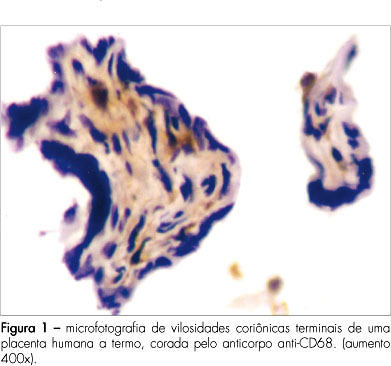
Summary
Revista Brasileira de Ginecologia e Obstetrícia. 2009;31(2):61-67
DOI 10.1590/S0100-72032009000200003
PURPOSE: to evaluate the quality of life and sexuality features of women with breast cancer, according to the type of surgery they underwent and their sociodemographic characteristics. METHODS: transversal study with 110 women treated for breast cancer, for at least one year in the Centro de Atenção Integral à Saúde da Mulher of UNICAMP. The quality of life was assessed by the WHOQOL-bref questionnaire, and the issues on sexuality, by a specific questionnaire in which Cronbach's Alpha coefficient was used to validate the concordance of responses (alpha=0.72) and the technique of factor analysis, with the criterion of self value and variance maximum rotation, resulting in two components: intrinsic or intimacy ( how the woman sees herself sexually) and extrinsic or attractiveness (how the woman believes the others see her sexually). Sociodemographic variables have been assessed according to the WHO questionnaire, and the sexuality components, through the Kruskal-Wallis followed by the Mann-Whitney's test and Spearman correlation test. RESULTS: age, schooling, type of surgery and lapse of time from the surgery did not influence the quality of life concerning physical, environmental, and psychological aspects, as well as the social relationships. Women with a stable marital relationship got higher scores in the psychological area (p=0.04) and in the area of social relationships (p=0.02). Higher socioeconomic level influenced the quality of life concerning physical appearance (p=0.01) and environment (p=0.002). Regarding the sexuality, age had influence in the extrinsic component (p=0.0158). Women with a stable marital relationship had higher scores of quality of life in both components of sexuality. Higher schooling influenced in a positive way the intrinsic factor. Women submitted to quadrantectomy or mastectomy with immediate breast reconstruction showed higher scores relating to attractiveness in comparison to mastectomized women without reconstruction. CONCLUSIONS: better socioeconomic level and better schooling, stable marital relationship and surgery with breast conservation are linked to better rates of quality of life, including sexuality.